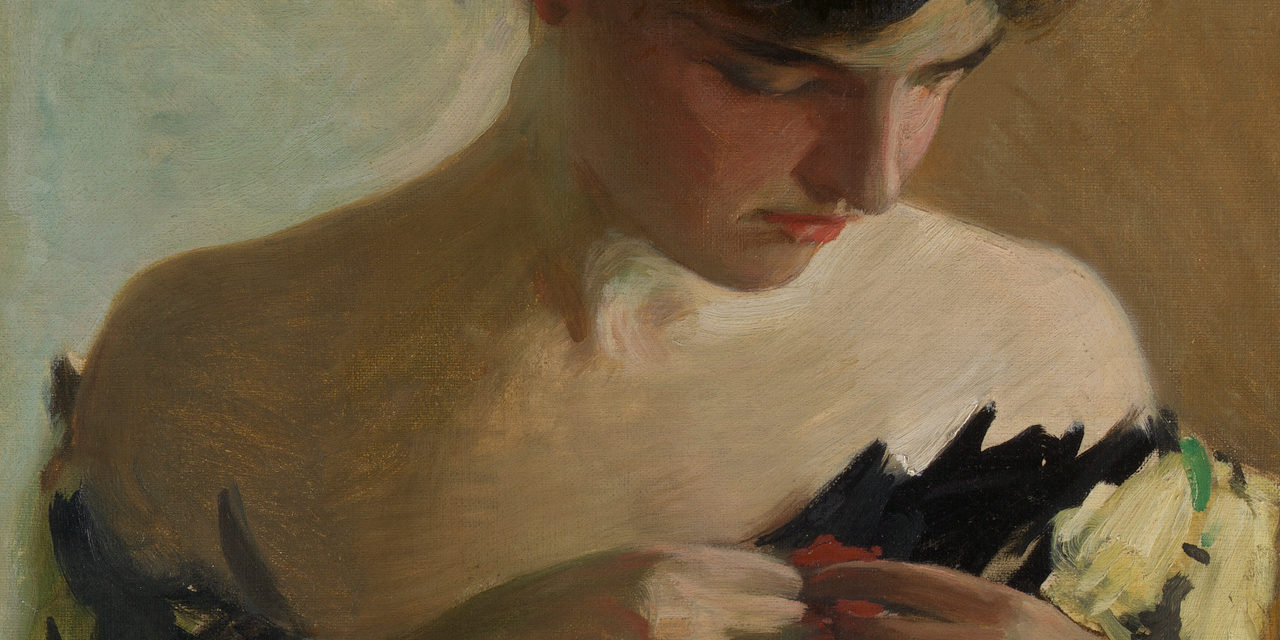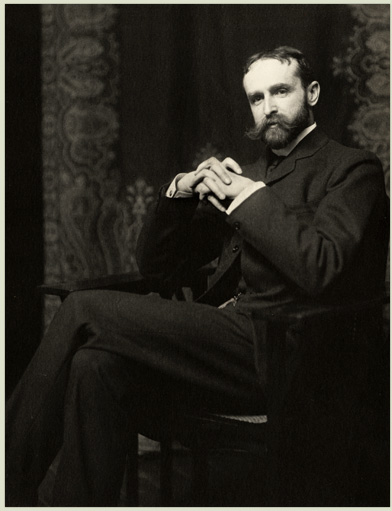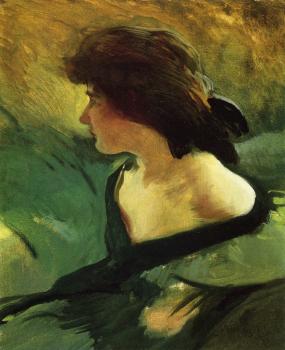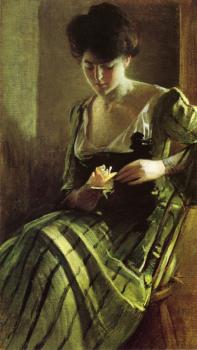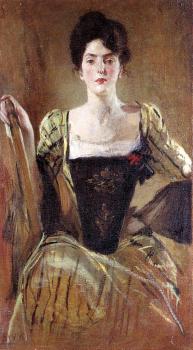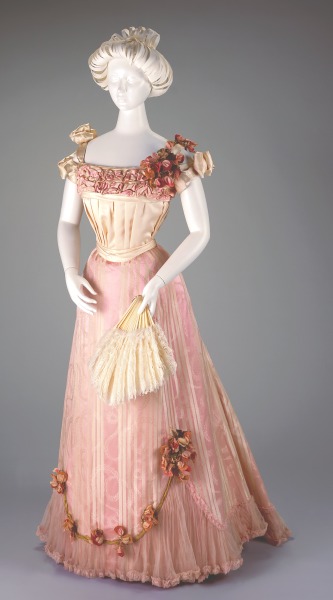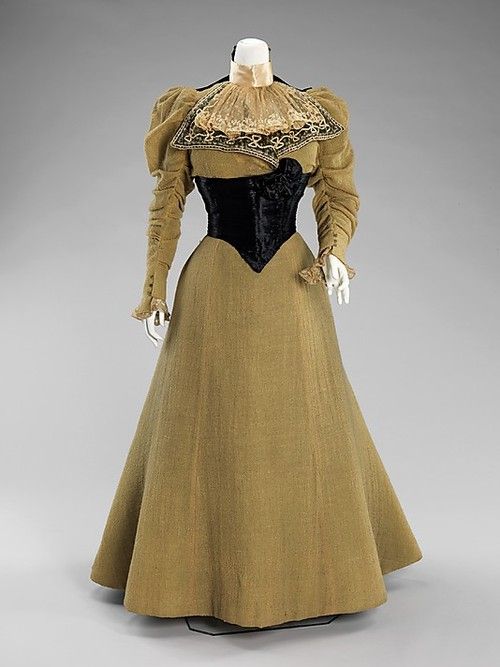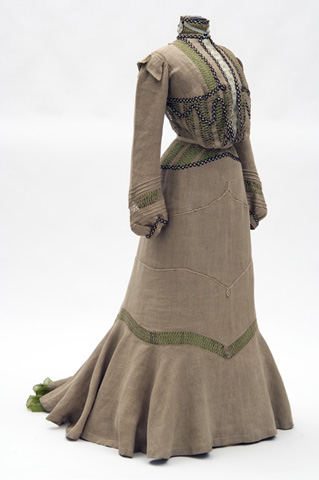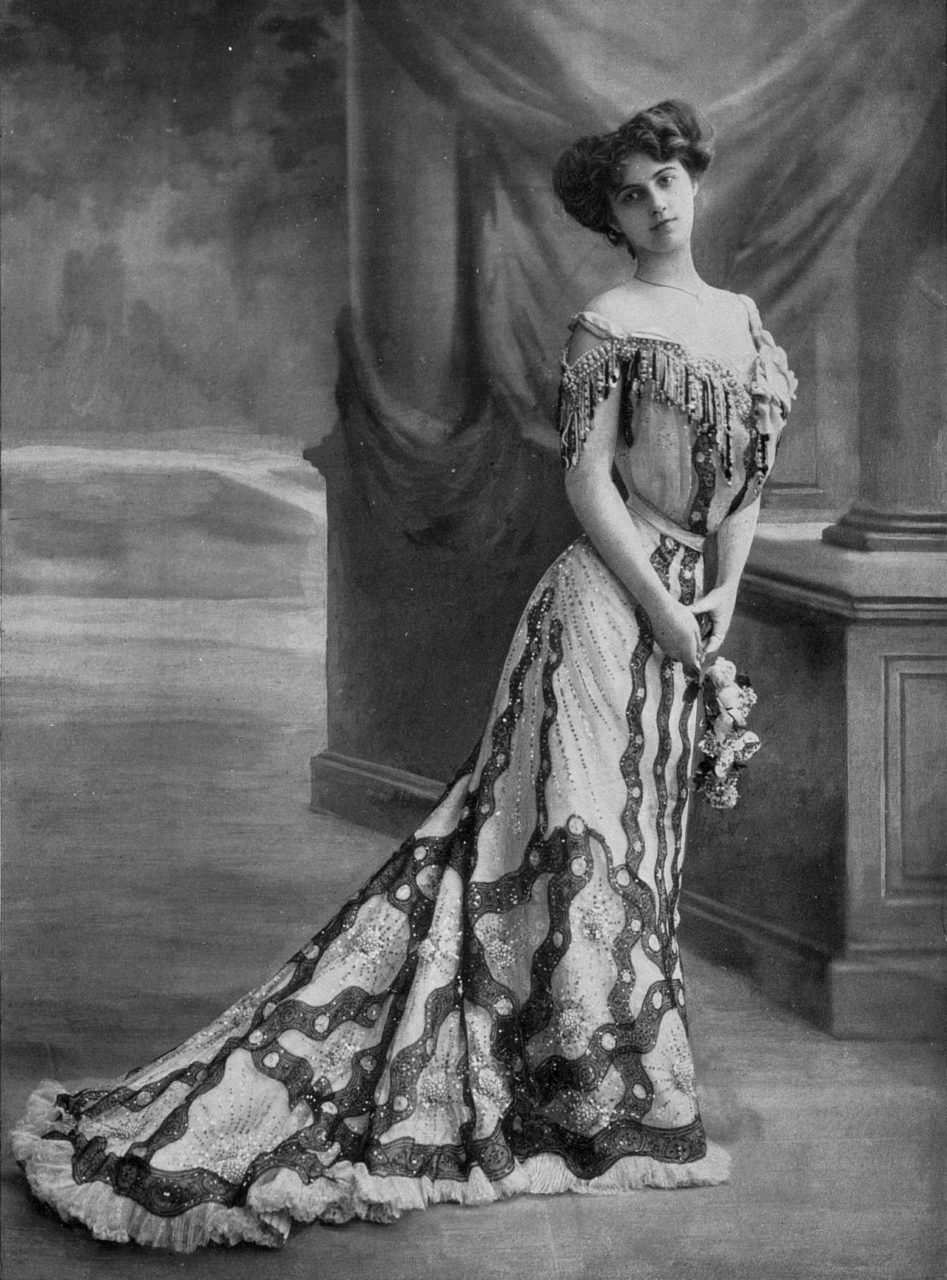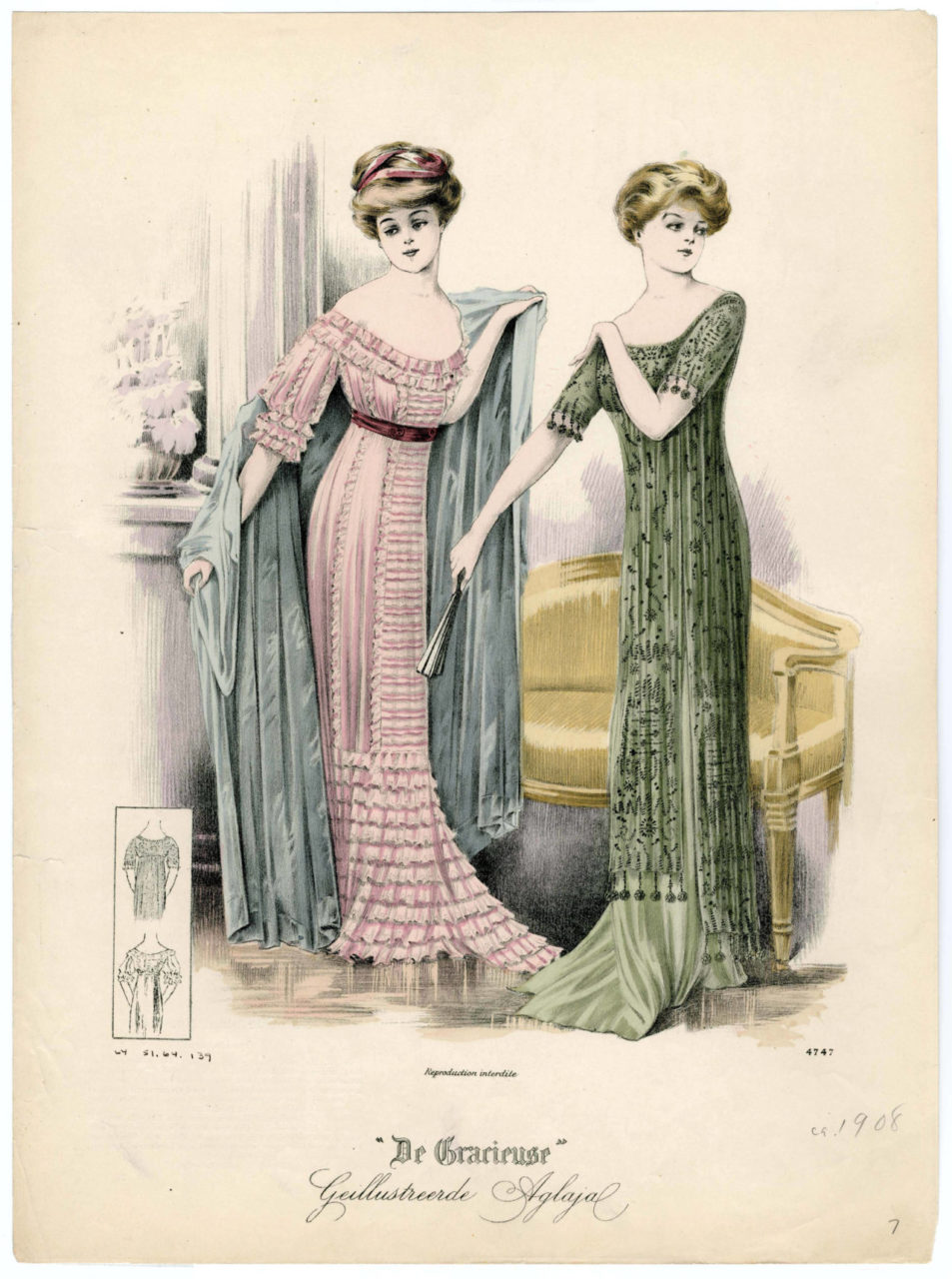Alexander replicated this same evening gown in paintings over a six-year period as it slowly progressed from fashionable to outdated.
About the Artwork
An American painter and illustrator, John White Alexander (Fig. 1) began his career in New York in 1875 working for Harper’s Weekly. In 1877, Alexander moved to Paris for formal art training. From there he traveled to Bavaria, Italy, and back to New York. By 1881, he was on his way to becoming a successful painter, and by 1893, both his American and European reputations were flourishing. From his early landscapes and genre scenes to his later psychological portrait studies of women, Alexander received a reputation for impressive, flowing lines (Harvey). Alexander’s mastery of this aspect is clearly visible in Study in Black and Green and can be compared to his later painting Young Girl in Green Dress (Fig. 2). The Met describes Study and Alexander’s skill as follows:
“Here, a young beauty is absorbed in nothing more consequential than pinning a bauble or blossom to the low neckline of her elegant evening gown. The skirt’s sinuous striped pattern, the curves at the knees and shoulders, and the contour of the upswept hair justify the description of Alexander as ‘the painter of the flowing line.’ His dazzling brushwork is especially notable in the rendering of the rich fabrics and in the otherwise plain background.”
As the painting is titled ambiguously, the identity of the sitter is unknown. This practice of not explicitly stating the sitter’s name is typical of Alexander because his focus was on the aesthetics and execution rather than on portraying a particular sitter. In John White Alexander and the Construction of National Identity (2003), Sarah Moore details this concept:
“Alexander [inverted his] priorities from representation of an individual to decorative treatment of the figure… The titles of Alexander’s paintings… deemphasized the identity of the model, thus subverting the traditional meaning of a portrait, and underscored aesthetic motive… J.W. Alexander’s subjects are not women, they are merely this means of expression.” (34-35)
While it is possible that the models for Young Girl in Green Dress (Fig. 2) and Study in Black and Green were the same person, he clearly worked with a variety of different models even in the same vein of black and green; see Young Woman Arranging Her Hair (Fig. 3).
Fig. 1 - Zaida Ben-Yusuf (British, 1869-1933). John White Alexander, 1856-1915, 1901. Platinum print. Washington, DC: Smithsonian Institution. Source: NPG
Fig. 2 - John White Alexander (American, 1856-1915). Young Girl in Green dress, date unknown. Oil on canvas; 60.96 x 50.8 cm (24 x 20 in). Private Collection. Source: The Athenaeum
Fig. 3 - John White Alexander (American, 1856-1915). Young Woman Arranging Her Hair, ca. 1890-1895. Oil on canvas; 100.97 x 55.88 cm (39.75 x 22 in). Private Collection. Source: The Athenaeum
John White Alexander (American, 1856–1915). Study in Black and Green, by 1906. Oil on canvas; 127 x 101.9 cm (50 x 40 1/8 in). New York: The Metropolitan Museum of Art, 08.139.1. George A. Hearn Fund, 1908. Source: The Met

About the Fashion
Like any other painting that features fashion, the question of fashionability must be answered by looking at the context. At first glance, the dress in Study in Black and Green appears to be a pretty, beautifully draped green and black striped evening gown. As research is conducted, however, about John White Alexander and his other paintings, it quickly becomes clear that Alexander had an affinity for green dresses with black accents (Figs. 2-3). In fact, the same exact gown that is depicted in Study in Black and Green is also featured in A Rose (Fig. 4) and The Green Gown (Fig. 5).
Fig. 4 - John White Alexander (American, 1856-1915). A Rose, ca. 1900. Oil on canvas; 101.6 x 57.15 cm (40 x 22.5 in). Private Collection. Source: The Athenaeum
Fig. 5 - John White Alexander (American, 1856-1915). The Green Gown, ca. 1904. Oil on canvas; 102.24 x 57.15 cm (40.25 x 22.5 in). Private Collection. Source: The Athenaeum
Fig. 6 - Artist unknown. The Queen, November 1901. Fashion plate. New York: FIT Special Collections, TT500 .Q3. Source: FIT Special Collections
An evening gown from approximately the same time can be seen in the November 1901 fashion plate of The Queen (Fig. 6). It features a similar silhouette, neckline, sleeve shape, and flower detailing. Not only are the paintings themselves important–so are the years in which Alexander created these paintings. In terms of chronology, Alexander painted A Rose, then The Green Gown, and then Study in Black and Green. These three paintings were completed around 1900, 1904, and 1906, respectively. The integrity of the dress’s fashionability is threatened by its reuse over several years. It was probably created between 1899 and 1901, like the pink evening dress by Donegan & Willging in figure 7. Yet it is unfair to discredit the gown’s fashionability without also considering the popular styles and trends of the decade. In La Belle Epoque (1968), the Costume Society suggests that fashion is not as transient as it seems:
“If one can accept the fact that fashion is a very slowly evolving process, in spite of the sudden pronouncements in some fashion articles in newspapers and magazines, one can understand that the shapes of the next fashion may be seen in the present and the shapes of the present fashion may be seen in the past.” (26)
The 1890s witnessed the decline of the bustle and the rise of the straight-front corset and fashions that created a sinuous, curving line in dress. The Victoria and Albert Museum explains that this corset:
“was fashionable during the 1900s. It thrust the hips backwards and forced the chest forward into a fashionable pouter-pigeon shape, emphasised with puffed, frilly blouses that were often embellished with decorations like lace collars and broad ribbon ties.”
Compare the green and black gown to those in figures 8 and 9. The dress in figure 8 dates from the end of the 1890s, with width at the upper chest and shoulders, a wide skirt, and a smooth, structured torso. The dress in figure 9 exemplifies the first few years of the 1900s, with its slouchier, dropped silhouette–the skirt only flares more towards the bottom, the bodice is bloused at the lower front, and the width has gone out of the shoulders and migrated towards the sleeves. Alexander’s dress, with its low, tight shoulders and smooth stomacher, appears to combine aspects of the two, showing that it was made around 1900.
In a broader description of fashion at the turn of the century, Millbank and Koda provide the following in Fashion: A Timeline in Photographs: 1850 to Today (2015):
“The turn of the twentieth century ‘S’ silhouette is a head to toe affair: a plateau hat perched atop long hair arranged with a chignon high on the head…, a bodice swollen at the waist in front, a handspan ‘wasp’ waist, and a slightly protruding black of the skirt ending on the ground with a slight train.” (100)
Fig. 7 - Mary Donegan & Katherine Willging (American, active 1880-1895 & 1889-1897). Evening dress: Bodice and Skirt, 1898-1901. Silk. Cincinnati Art Museum, 1958.45. Gift of Mrs. Chase H. Davis. Source: CAM
Fig. 8 - Fox (department store) (American). Dress, 1896-99. Wool, silk. New York: Metropolitan Museum of Art, 2009.300.833a, b. Gift of the Brooklyn Museum, 2009; Gift of Mary Louise Deming in memory of her mother, Mrs. Nelson Lloyd Deming, 1959. Source: MMA
Fig. 9 - Minnie & Sarah Leonard (American). Linen day dress, 1901-2. St. Paul: Minnesota Historical Society, 6396.36.1.A,B. Source: MNHS
Fig. 10 - Ernest Raudnitz (French, active 1883-1910s). Evening dress, Les Modes July 1, 1902. Paris: Bibliothèque Nationale de France, FOL-V-4312. Photo by Reutlinger. Source: Gallica
Fig. 8 - Artist unknown. De Gracieuse, ca. 1908. Fashion plate. New York: The Metropolitan Museum of Art, b17520939. Gift of Woodman Thompson. Source: The Met
The evening gown in Study in Black and Green is not quite to that point, but may already be worn over one of the new straight-front corsets which came into fashion around 1899. Even though the bodices bloused out around the waist, the goal was a smooth, almost convex line from waist to toe rather than a rounded belly and flared-out skirt in profile (fig. 10).
Paul Poiret’s ‘uncorseted’ straight-line dress (fig. 11) had yet to make its appearance until 1908, which was two years after Alexander completed Study in Black and Green. Between 1903 and 1906, the curvy look peaked before slimming down again. The contemporary trend in art and design that influenced these styles was Art Nouveau. In The Fashion Reader (2016), Linda Welters and Abbe Lillethun connect the new corset to curvilinear art:
“Art Nouveau was a style prevalent in the 1890s and early 1900s, whose influence was felt in fashion as well as in a variety of other forms ranging from jewelry to architecture. It can be understood as the bridge between traditional nineteenth-century art styles and those of the new twentieth century… the silhouette of women’s clothing from 1900 to 1908 echoed the S-curve of the art nouveau style. The fashionable, straight-fronted corset tilted the upper body forward and thrust the hips backward.” (43)
In the end, was this gown fashionable? At his first use of it around 1900, it was. But because Alexander replicated the same evening gown in three paintings and clearly aimed to capture an aesthetic and composition rather than create a portrait of a real person, it probably appeared rather outdated by 1906 when he was creating this last version of this work.
References:
- Harvey, Eleanor Jones. “Alexander, John White | Grove Art.” Accessed May 7, 2018. Oxford Art Online.
- Costume Society. La Belle Epoque: Costume 1890-1914. Proceedings of the First Annual Conference of the Costume Society, April 1967. London: Victoria and Albert Museum, 1968. Worldcat.
- Milbank, Caroline, and Harold Koda. Fashion: A Timeline in Photographs: 1850 to Today. New York : Rizzoli International Publications, Inc., 2015. Worldcat.
- Moore, Sarah J. John White Alexander and the Construction of National Identity: Cosmopolitan American Art 1880-1915. University of Delaware Press, 2003. Worldcat.
- The Met. “John White Alexander | Study in Black and Green | The Met.” Accessed May 7, 2018. https://www.metmuseum.org/art/collection/search/10067.
- Victoria and Albert Museum. “History of Fashion 1900 – 1970,” July 11, 2013. http://www.vam.ac.uk/content/articles/h/history-of-fashion-1900-1970/.
- Welters, Linda, and Abby Lillethun. The Fashion Reader. Berg, 2016. Worldcat.

